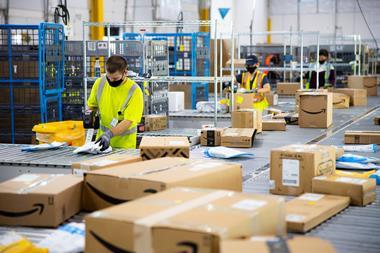Amazon’s update last week showed that it is not immune to the disruptive forces battering retail at present – but any smugness about the online Goliath’s challenges is missing the point.
While the retailer, a star of the pandemic, piled on sales in its third quarter, profits plummeted. Amazon acknowledged it was being hit by the same storms shaking the industry, such as supply chain snarl-ups, labour shortages and rising costs affecting everything from wages to freight.
The pressure will likely prove costly – very costly, in fact – adding up to “billions” during the golden quarter, new chief executive Andy Jassy warned.
Some retailers, knocked for six as Amazon ate into category after category over the years, no doubt enjoyed a feeling of schadenfreude. But the billions of dollars earmarked by Amazon to ride out the difficulties, rather than add to the bottom line, are a symbol of the etailer’s strength rather than weakness.
Amazon can financially outgun pretty much all of its rivals. Sacrificing profits to build and sustain its business was key to the etailer’s original success as it spent without compunction to wow consumers with its customer-centric efficiency and service.
The billions of dollars earmarked by Amazon to ride out the difficulties, rather than add to the bottom line, are a symbol of the etailer’s strength rather than weakness
Now it is treading exactly the same path. As some choose, or are forced, to keep a cap on costs, Amazon will throw every cent it can at solving the problems and trading as strongly as possible.
Jassy made that clear. He observed: “We’ve always said that when confronted with the choice between optimising for short-term profits versus what’s best for customers over the long term, we will choose the latter.
“In the fourth quarter, we expect to incur several billion dollars of additional costs in our consumer business … all while doing whatever it takes to minimise the impact on customers and selling partners this holiday season. It’ll be expensive for us in the short term, but it’s the right prioritisation for our customers and partners.”
That should send a shiver down the spines of rivals as cost inflation is ratcheted up at the most important trading period of the year – a time at which some retailers still make the bulk or even all of their annual profits.
Retail arms race
Over the past few months there has been a retail arms race to muster everything from product availability to truck drivers. John Lewis, among others including Amazon, has chartered extra ships to get product into the market. Along with competitors such as Marks & Spencer, it has offered signing-on fees for truckers. Amazon itself is paying as much as £3,000 as a welcome bonus to new warehouse employees.
Supply problems and labour shortages are all feeding inflation, making shoppers nervous as other essentials such as fuel rise in cost.
This Christmas the battle for supply security and talent will result in retail losers as weaker players find themselves unable to go up against big companies with deeper pockets – and Amazon has the deepest of all.
When the Covid pandemic first broke out, every retailer that had the ability to do so shored up their balance sheets as they put in place new financing arrangements.
Cash was king then, and so it is again – as much and maybe even more so than when the coronavirus outbreak was at its height.
This Christmas the battle for supply security and talent will result in retail losers as weaker players find themselves unable to go up against big companies with deeper pockets – and Amazon has the deepest of all
The additional expenditure may be unwelcome, but it is simply payment for entry to the party if Amazon is to be prevented from capturing further ground.
Retailers will also need to go toe-to-toe with Amazon when it comes to execution, in which the Seattle powerhouse is a past master.
Amid all the uncertainty of the final quarter, accurate online availability information and reliability of delivery will be key, requiring deft management of time slots and certainty for customers that they will get their Christmas goodies before the big day.
With almost two full months to go, retailers still have the opportunity to ensure they get such basics right. That will also allow them to better manage and influence the patterns of demand, encouraging early shopping and minimising the risks of a last-minute rush.
The sooner they can get shoppers’ cash in the bank, the more they will be able to hold their own even as Amazon opens its coffers.
Amazon’s warning that life is getting “expensive” is no reason to crow that it shares the same vulnerabilities as others – it’s a red alert that all retailers need to be on top of their game like never before this festive season.
- Sign up for our daily morning briefing to get the latest retail news and analysis































No comments yet